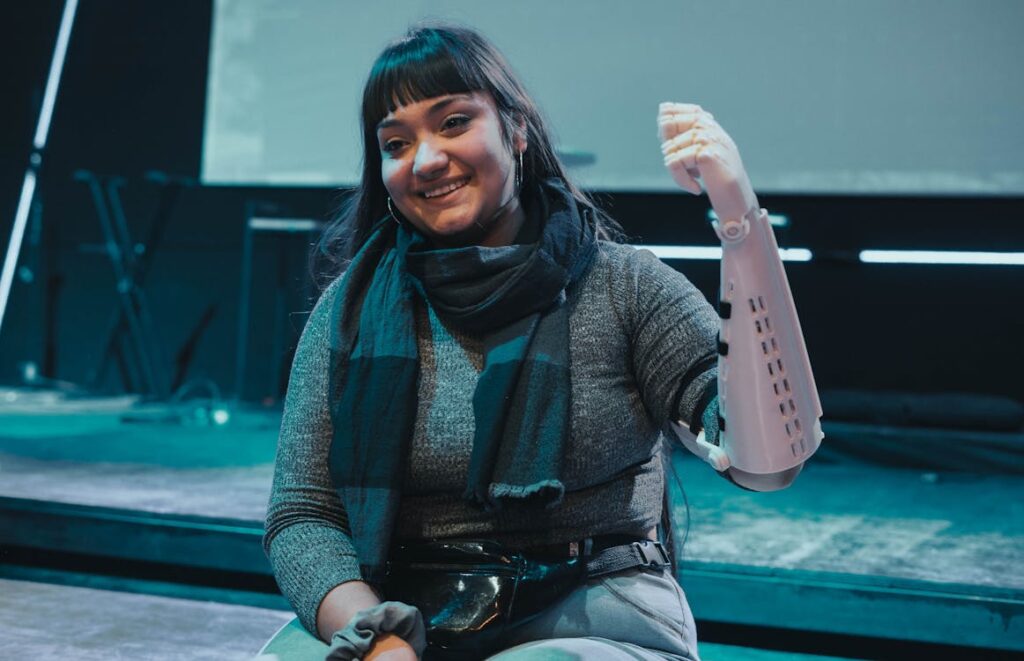Progress is not always a straight line. Especially when it comes to rehabilitation, small wins can feel like big moments—but they also come with setbacks, tired days, and dips in motivation. For users working with prosthetics, rehab can be physically demanding and emotionally draining. Staying committed takes more than just willpower—it takes smart design.
That’s where adaptive difficulty steps in.
Adaptive difficulty is a simple yet powerful concept. It means that the challenge adjusts to match the user’s current ability. Not too easy, not too hard—just right. It keeps people interested, motivated, and moving forward without pushing them past their limits. In gaming, this technique is used to keep players hooked. In rehabilitation, it can mean the difference between a user giving up or growing stronger every day.
At Robobionics, we’ve been working to bring adaptive difficulty into every part of the rehab journey—especially for those using prosthetic limbs. Because when the challenge fits the person, instead of forcing the person to fit the challenge, amazing things happen.
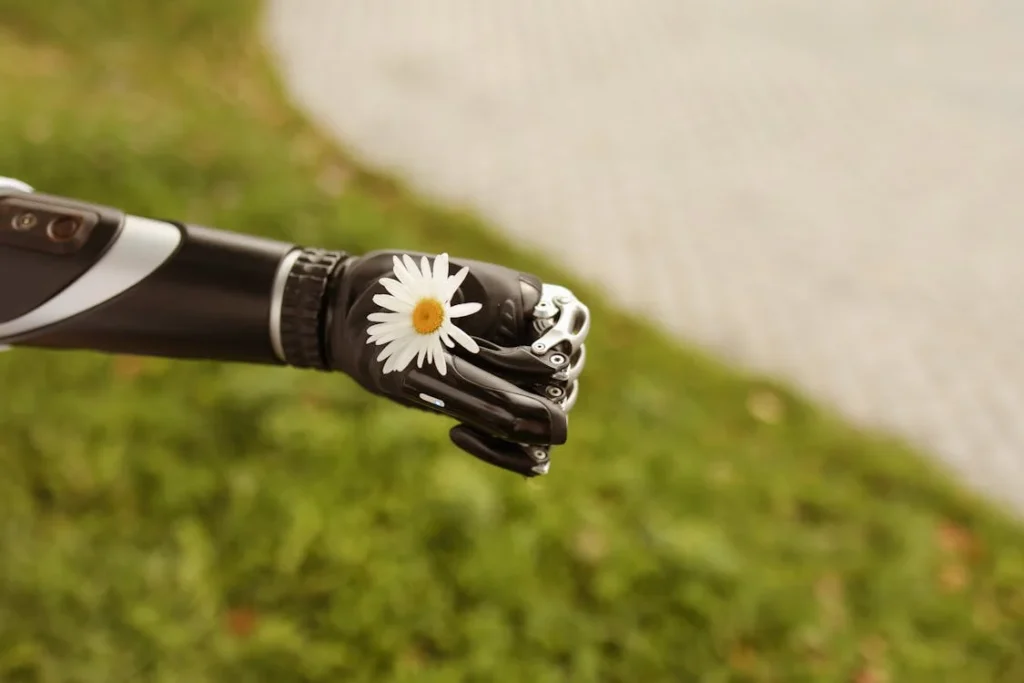
Understanding Adaptive Difficulty in the Context of Rehab
What Adaptive Difficulty Really Means
Adaptive difficulty is the idea that a task, challenge, or system changes based on how well someone is doing. If you’re struggling, the task gets easier. If you’re doing well, it becomes more challenging. It adjusts itself—not just once, but constantly, moment by moment. The goal isn’t to make things easy. The goal is to keep things just hard enough to be engaging, but not so hard that you feel frustrated or overwhelmed.
In games, this means enemies get smarter or puzzles get trickier when players perform well. But in rehabilitation, it’s even more important. It’s not about entertainment—it’s about making recovery sustainable.
For someone learning to use a prosthetic arm or leg, even simple movements take effort. Every repetition requires focus. Every improvement matters. If therapy is too easy, the body doesn’t adapt or grow. But if it’s too difficult, the person feels defeated. They might skip a session or stop trying altogether. This is where adaptive difficulty becomes essential. It listens to the body. It reads the performance. Then it finds the right balance.
Why Fixed Difficulty Doesn’t Work in Rehabilitation
Traditional rehabilitation often follows fixed routines. You’re given exercises to repeat, regardless of how you feel that day. Maybe you’re tired. Maybe you’re having a great day. Maybe you’re still sore from yesterday. But the plan doesn’t change. You still do 10 reps. You still walk 100 steps. You still try to grip the same object for the same amount of time.
This might work for a while, especially in the early stages. But over time, it creates a gap. The body and mind are always changing, but the therapy stays the same. That’s when problems arise.
If a patient performs below expectations, they feel they’ve failed. If they perform well, they might get bored or plateau. And when things don’t feel tailored to your needs, motivation drops. We’ve seen this happen with patients across India—from city clinics to rural homes. Progress slows, and sometimes stops.
By using adaptive difficulty, we close that gap. We let the rehab experience grow with the person, not away from them.
How Adaptive Difficulty Works With Prosthetic Training
Let’s say someone is learning to use a bionic hand. One of the key training exercises is to grasp objects with the right amount of pressure. If the user squeezes too hard, the object breaks (virtually). If they don’t squeeze hard enough, it slips away.
In a fixed system, the object’s sensitivity remains constant. The user has to keep trying until they get it right. This can be frustrating, especially if they can’t quite figure out what’s going wrong.
But in an adaptive system, the sensitivity of the object changes in real time. If the user is struggling, the object becomes more forgiving—less slippery, less fragile. As the user improves, the object becomes more challenging. The grip must become more precise. Each level of success unlocks a slightly harder version of the same task.
This keeps users engaged. They feel a sense of mastery without being overwhelmed. Every win feels earned. Every loss feels like a learning moment—not a dead end.
We’ve applied the same thinking to walking drills. If someone is using a below-knee prosthesis and struggling with balance, we reduce the difficulty of the virtual walking surface. The task might begin with a flat road. Once balance improves, the path becomes uneven—like a gravel track or grassy field. The goal stays the same (walk confidently), but the challenge adjusts.
Real-Time Feedback: The Heart of Adaptive Systems
For adaptive difficulty to work, the system must know what’s happening right now. That’s where wearables and smart sensors come in. They read body signals—muscle activation, joint angle, foot pressure, speed, even tremors. This data flows into the rehab platform, which then decides how to respond.
If muscle fatigue is detected, the system may suggest a lighter load or fewer reps. If the user is performing smoothly, it might increase the complexity—adding distractions, multitasking, or precision challenges.
It’s not about rewarding users or punishing them. It’s about responding to what their body is telling us—and helping them stay in the flow zone.
The “flow zone” is that sweet spot where the task is hard enough to be engaging, but not so hard that it causes stress. When users stay in this zone, they feel focused. They feel challenged, but in control. That’s the ideal mental space for growth.
A Human Story: Adapting to the Right Challenge
One of our users, Arjun, came to Robobionics after a traumatic accident. He was fitted with a below-elbow prosthetic arm and was determined to get back to work as a tailor. The early stages of rehab were tough. Threading a needle seemed impossible.
At first, we gave him a game that required pinching virtual coins and placing them into small slots. He struggled. His grip was too shaky. He got frustrated and asked if he was doing something wrong.
The system picked up his muscle fatigue and reduced the challenge. The coins became larger. The slots widened. Arjun could now succeed. And once he did, his confidence grew. He didn’t want to stop. By the next week, the game had gradually returned to its original level. He didn’t notice the shift—he just felt more capable.
Two months later, Arjun was threading actual needles.
That’s adaptive difficulty in action. It doesn’t scream, “Here’s an easier level.” It quietly shifts to meet the user where they are—and lifts them without making them feel small.
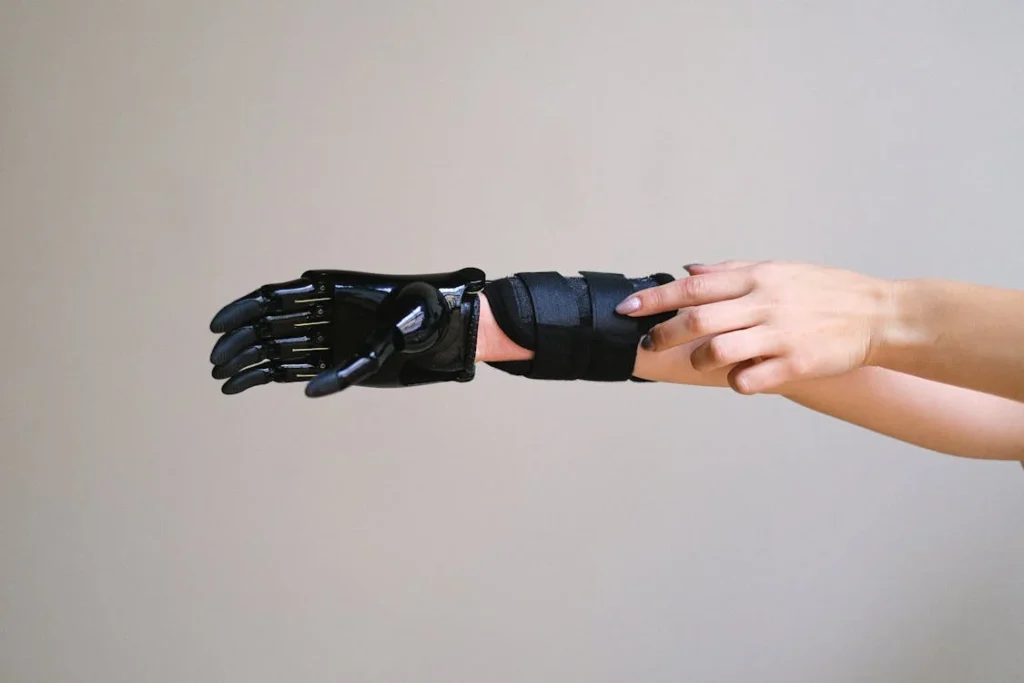
Designing Systems That Know When to Push and When to Pause
Why Timing Is Everything in Rehab Progress
In rehabilitation, it’s not just what you do—it’s when you do it. One extra push at the wrong time can lead to pain, fatigue, or discouragement. But one pause at the wrong moment can stall momentum. This is the delicate balance that every therapist tries to maintain manually. But when we build intelligent rehab systems powered by adaptive difficulty, the timing becomes more precise, more intuitive, and more patient-friendly.
At Robobionics, we believe that a system should not only respond to physical signals—it should understand them. That means knowing when the user is ready for more challenge and when they need to take a step back—not because they said so, but because their body is saying so.
This approach makes therapy safer, more respectful of human limits, and—most importantly—more sustainable. Because burnout doesn’t happen overnight. It happens quietly, when small signs are missed. And adaptive systems are designed to catch those signs early.
Pushing Forward: What Smart Progression Looks Like
Pushing users forward doesn’t mean piling on difficulty for the sake of it. It means recognizing patterns that show readiness. Maybe a patient has completed a grip control task three times in a row with perfect form. Or maybe they’re walking faster with fewer stumbles. In these cases, the system can gently increase the challenge—not in a dramatic way, but in small, almost invisible steps.
For example, the weight of a virtual object may increase by 5%. The walking surface may tilt slightly. A new visual distraction may be added to test focus. These are micro-adjustments, but they activate new parts of the brain and body. They ask the user to adapt without overwhelming them.
This kind of gentle push keeps users interested. It builds their sense of mastery. It helps them discover strength they didn’t know they had. More importantly, it keeps the therapy experience fresh, which is key in long-term rehab.
We often say: “Don’t give them the biggest hill. Give them the next step up.”
Knowing When to Ease Off: Spotting the Subtle Signals
Equally important is knowing when to pause. Rehab culture sometimes glorifies the idea of “pushing through.” But in reality, pushing too hard—especially with a prosthetic limb—can cause more harm than good. It can lead to soreness, swelling, or mental burnout.
That’s why our adaptive systems are built to monitor micro-signals of strain. These include:
- Shorter motion range
- Increase in tremor
- Delayed reaction time
- Drop in grip strength
- Lower engagement with the task
Even facial tension, blinking rates, or body posture (captured through camera input) can offer clues.
When these signs appear, the system doesn’t just stop the task. It adjusts it. It may introduce a cooldown activity. It may shorten the session. It may offer a breathing break. And it always gives the user a sense of control—by explaining the change as support, not failure.
This gentle guidance helps users feel cared for, not corrected. It builds trust between the system and the user. And trust is everything when someone is navigating a challenging recovery.
Preventing Mental Fatigue in High-Motivation Users
Interestingly, the users who are most at risk of burnout are often the most motivated. They want to recover fast. They push themselves hard. They ignore discomfort. And while this drive is admirable, it can backfire.
Our systems are designed to spot this kind of hidden overload. If someone is speeding through tasks with perfect accuracy but showing signs of physical strain, the system offers a variety break—maybe switching to a coordination task or a low-intensity challenge with a fun, story-based theme.
This keeps the brain engaged without exhausting the body.
We’ve also found that incorporating “wins” during moments of decline helps a lot. If a user is fatigued but still trying, we reward effort—not just outcome. The game might say, “You’ve trained consistently for 5 days—take a recovery day!” This kind of encouragement lets users feel accomplished without having to overdo it.
Feedback Loops: Keeping the Human in the Loop
No matter how smart a system becomes, we believe rehab should always include the human voice. That’s why every adaptive module we build is designed to feed data back to therapists and caregivers.
Therapists can review not just what the patient did—but how they responded emotionally and physically. Did they hit a wall? Did they improve steadily? Did they struggle more in the evening than in the morning?
This data helps the therapist adjust broader plans, provide reassurance, or even spot deeper issues that a machine can’t detect.
Users also have access to their own feedback. But we make sure it’s simple, visual, and friendly—not cold or robotic. Instead of showing numbers alone, we show progress with colors, stars, or milestones: “You moved smoother today!” or “That new grip felt strong!” These small celebrations go a long way.
A Personal Example of Balance in Action
We recently worked with a school teacher named Suman, who lost her leg in an accident and was fitted with a robotic knee. In her first few weeks of therapy, she wanted to “beat the system.” She logged extra hours, tried advanced drills, and even skipped cooldowns. At first, it looked like she was ahead of schedule.
But the system picked up something her body wasn’t saying out loud. Her gait became stiffer. Her steps slowed slightly. Her balance tests dropped by 8%. These weren’t dramatic failures—just quiet signs of strain.
Instead of pushing her harder, the system shifted. It gave her balance games with slower pace and softer visuals. It added breathing cues and removed time pressure. Suman didn’t even notice the change at first. But after a week, her metrics bounced back—and so did her mood.
That’s the kind of therapy that listens. That’s the kind of system that adapts with care.
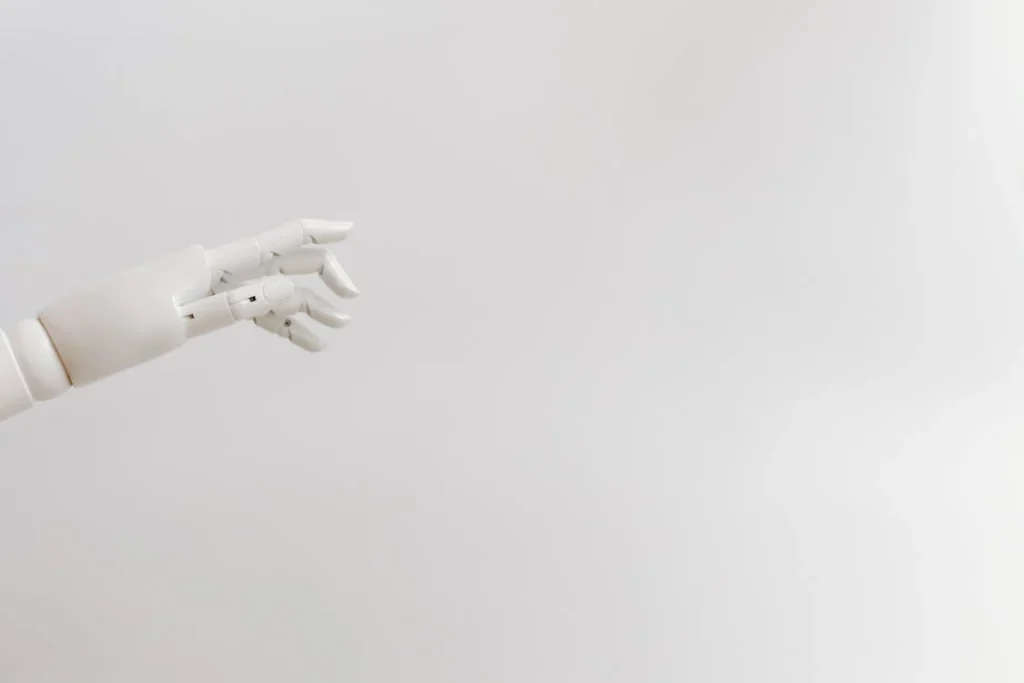
Adaptive Difficulty in Group Settings: Balancing Individual Needs in Shared Rehab Spaces
Why Group Therapy Still Matters
While personalized rehab has become the gold standard, group therapy sessions are still very common—especially in community clinics, public hospitals, and rehab centers with limited staff. In places like India, where resources are often stretched, group rehab helps ensure more people receive care, even if the sessions aren’t one-on-one.
Group settings also have unique benefits. They create a sense of community. They help patients feel less alone. Watching someone else take a step, grip a bottle, or complete a game level often inspires others to try harder. Encouragement becomes a shared experience. Success becomes a group celebration.
But there’s a hidden challenge: no two patients are alike. One might be walking independently. Another might still be learning how to stand. One might be dealing with muscle fatigue. Another might be ready to increase their resistance. Yet the group receives the same set of instructions. This creates a mismatch in ability and expectation. It can lead to frustration—or worse, shame.
That’s why bringing adaptive difficulty into group settings is not just helpful. It’s necessary.
How Adaptive Systems Create Individual Experiences Within Shared Sessions
At Robobionics, we’ve worked to develop a system where each user in a group therapy room receives a personalized experience—even if everyone is playing the same game or following the same general plan. Here’s how it works.
Each participant wears their own set of wearable sensors—small, lightweight, and linked to their personal rehab profile. When the group starts an activity, the core challenge is shared. For example, everyone may be doing a balance game on screen or a grip-based challenge. But how that challenge unfolds depends on the individual’s real-time data.
If one user has high grip strength, their object becomes smaller or slipperier. If another user is still building strength, their object remains stable and large. One sees a more complex screen. Another sees a simplified version. No one is told, “You’re on the easy level” or “You’re behind.” The difficulty shifts quietly, respectfully, and in sync with the user’s progress.
This way, everyone stays engaged. No one gets left behind. And no one feels they need to “keep up” with the person beside them.
Managing Group Energy Without Causing Burnout
Group dynamics can be powerful, but also intense. Some users push themselves too hard because they don’t want to look weak. Others may feel discouraged if someone else improves faster. That’s where the adaptive system plays another role—not just adjusting the difficulty of the task, but also managing energy flow in the room.
For example, if the group has been performing high-effort tasks for 20 minutes, the system can shift the session to a calmer phase. It might introduce a mindfulness game, a guided breathing exercise, or a light storytelling module that still involves movement but at a gentler pace. This subtle shift helps prevent collective fatigue.
In some cases, the system also identifies when an individual’s mood or focus has dropped—even if they say they’re fine. Maybe their motion tracking shows slower reactions. Maybe their posture has changed. The system can then offer a personalized rest cue—without stopping the whole group.
This creates an environment of compassion, not competition. Each person gets what they need, when they need it, without calling attention to it.
How This Works in Low-Tech Environments
One question we often get is: “Can this kind of smart, adaptive therapy work in places without high-end infrastructure?” The answer is yes—and we’ve proven it.
In some of our partner clinics in tier 2 and tier 3 towns, we use a simple setup: one shared screen, multiple Bluetooth sensors, and low-cost smartphones for personal feedback. The game visuals are basic, but they are synced to each person’s inputs. The therapist can monitor everyone on one dashboard. But each user’s experience is customized.
We’ve seen incredible results in these settings. Users feel included. Therapists feel empowered. And engagement stays high—not for a day, but for weeks and months.
This model works because it respects local realities. It doesn’t need expensive VR headsets or a separate computer for each person. It uses what’s available, and adapts the experience to fit.
Encouraging Social Motivation Without Pressure
Adaptive difficulty in group settings also supports something very important: social motivation. When a user sees others making progress, they’re naturally inspired. But instead of pushing themselves too far, they let the system guide their pace. They feel safe trying harder because they trust that the system will catch them if they go too far.
We’ve also added features where users can set team goals. For instance, if everyone in the group completes their balance drills for the day, the group “unlocks” a shared reward—like a storytelling break or a fun visual challenge. It’s not a competition. It’s a collaboration.
This builds a culture of support. One where users cheer for each other, but also understand that progress looks different for everyone.
Adaptive difficulty in group rehab doesn’t eliminate structure. It strengthens it—by making sure that structure includes everybody, not just the average.
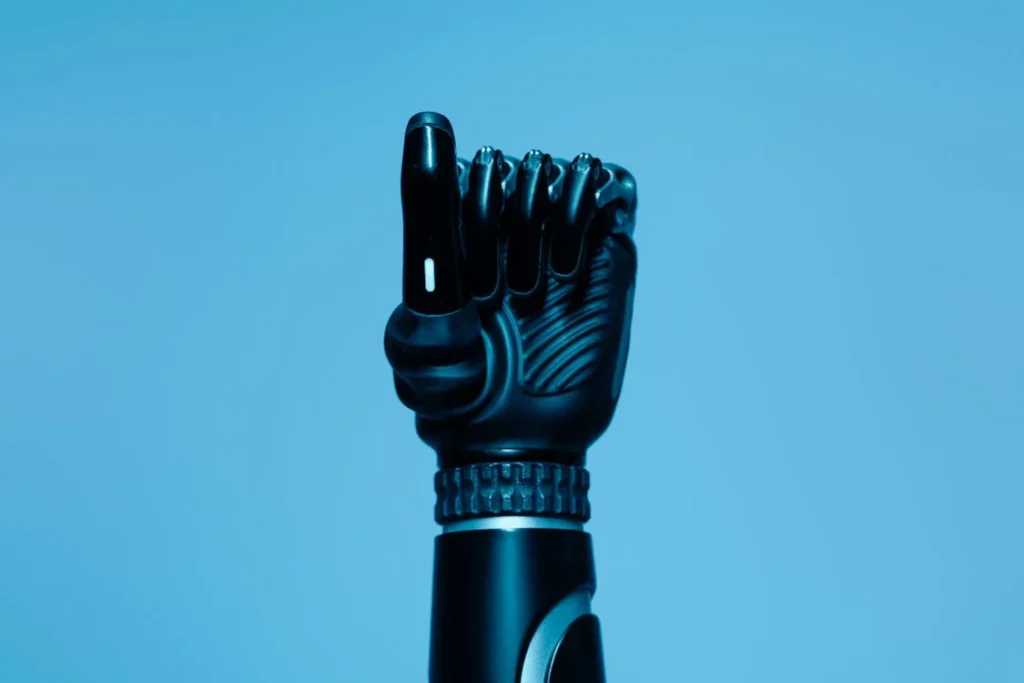
The Future of Adaptive Difficulty in Home-Based Rehabilitation
Why Home Is the New Rehab Center
In the past, rehabilitation meant visiting a clinic, meeting a therapist, and completing sessions under direct supervision. But now, the world is shifting. People want flexibility. They want care at their own pace, in their own space. This is especially true in India, where traveling long distances for therapy isn’t always practical or affordable.
Home-based rehab is no longer just a backup option—it’s becoming the primary mode of recovery for many prosthetic users. But for it to work, the therapy has to be smart. It has to respond to how the user is feeling each day. It has to give guidance, not just instructions.
That’s where adaptive difficulty shines. When brought into the home, it becomes a kind of quiet coach—watching, learning, and adjusting in the background while the user focuses on moving forward.
What an Adaptive Home Rehab Session Looks Like
Let’s imagine a user named Anita, recovering from an above-knee amputation. She lives in a small town and recently received her prosthetic leg. Her therapy takes place in her living room with a basic smartphone, a sensor band around her thigh, and a small screen showing her progress.
She starts a walking exercise. The system notices her pace is slower than usual. It also sees her step balance is off by 10% more than the day before. Without scolding, without delay, the game she’s working through quietly changes. The walking track becomes a little wider. The pace slows. A calming soundtrack replaces the usual upbeat one.
Now Anita feels supported, not judged. She completes her session. And because she could actually manage the challenge, she feels successful. That keeps her coming back tomorrow.
Next week, when she improves, the game shifts again—just enough to help her grow, without risking frustration.
This is adaptive rehab in its most powerful form: invisible, intuitive, and respectful.
No Therapist Nearby? No Problem
One of the most common concerns in home-based rehab is the lack of a therapist present. What if something goes wrong? What if the user gets tired or discouraged? Adaptive difficulty answers that concern in real time.
If the system senses repeated errors, signs of fatigue, or sudden drops in performance, it pauses the task. It might suggest a stretch break, switch to a less demanding game, or simply recommend rest. It does this gently—like a friend who knows you well.
But the system doesn’t work in isolation. All data is recorded and shared securely with the therapist. They can log in, see what Anita’s been doing, and send feedback or encouragement. This combination of smart tech and human support makes sure that no user is truly alone.
Creating Daily Wins That Build Habits
The hardest part of any home routine is staying consistent. Without structure, motivation fades. But adaptive systems help build habits by giving users daily wins. The difficulty adjusts to guarantee that the user always has something they can achieve—even if they’re tired or having a bad day.
Maybe it’s completing a movement with better timing. Maybe it’s keeping posture steady for longer. The system recognizes small improvements and rewards them with feedback: “Great effort today!” or “That last step was smoother!”
This might seem simple, but these micro-wins matter. They turn rehab into something positive. Something people want to return to. And over time, these small moments stack up into big changes—in mobility, in mood, in mindset.
Designing for Rural and Low-Tech Homes
At Robobionics, we’ve worked closely with users in remote parts of India. Some homes don’t have stable internet. Some families only have one shared phone. In these cases, we make sure adaptive systems still work.
Our devices are built to function offline, with local storage of progress. They sync only when internet becomes available. The interfaces are designed with minimal text, regional languages, and audio prompts. Instead of complex graphics, we use clear visuals and voice instructions that guide users at each step.
We believe adaptive therapy should never be limited by geography or income. It should reach the doorstep of anyone who needs it.
Blending Family Support With Smart Feedback
Home rehab doesn’t just include the patient—it includes the family. Parents, children, or spouses often play an active role in helping the user stay on track. That’s why our system gives simple summaries for family members too.
If a user has a good day, the system can prompt: “Anita completed her full walk today—give her a high five!” If the system notices strain: “Try offering a short back rub or helping her stretch.”
These suggestions build emotional support around the user. They create a circle of care—one where everyone understands what’s happening and how to help.
In many ways, adaptive difficulty at home is not just about changing the challenge. It’s about changing the culture of rehab—from something clinical and distant to something warm, personal, and close.

Integrating Adaptive Difficulty into Schools and Workplaces for Reintegration
Rehabilitation Doesn’t End at Home
For prosthetic users, real recovery goes beyond learning to walk, grip, or balance. The true test of rehab is re-integration—getting back to school, returning to work, participating in daily life without constant support. This step can be intimidating. Suddenly, users are not just training in a safe environment—they’re navigating real-world pressure, expectations, and social dynamics.
That’s why bringing adaptive difficulty into classrooms and offices is so important. It ensures that the support system doesn’t vanish when the patient walks out of a clinic or finishes home-based therapy. Instead, the system moves with them, helping them adapt to new environments without overwhelm.
At Robobionics, we’ve seen firsthand how small adaptive tools—when introduced at school or work—can make a huge difference in confidence, focus, and long-term success.
Understanding the Stress of Reintegration
When a student or professional returns after an amputation or prosthetic fitting, they carry more than a new limb—they carry fears. Will I be able to keep up? Will people stare? What if I drop something in front of others? What if I fall?
These thoughts create pressure. And pressure affects performance.
Reintegration environments are often structured for the average user. Schools have fixed lesson plans. Workplaces have tight deadlines. There’s rarely room for slow adaptation. That’s why users need smart systems that adjust to their real-time ability—even when no one else does.
That’s where adaptive difficulty becomes an invisible ally.
In the Classroom: Learning Without Falling Behind
Imagine a student with a prosthetic arm returning to school. They may need to type, write, draw, or carry books. Even if they’ve practiced these skills at home, doing them under classroom conditions—with peers, noise, and time pressure—can feel different.
We’ve developed classroom-friendly adaptive tools that can be installed on school tablets or computers. These tools monitor the student’s inputs—typing speed, writing pressure, grip steadiness—and adjust tasks accordingly.
If the student is struggling to complete a worksheet, the interface slows down scrolling. If they’re holding a pencil too tightly, the system suggests a grip change, gently, through vibration or screen prompt. If they do well, the task becomes slightly more complex to build skill. If they’re tired, it shifts toward low-pressure creative tasks like coloring or matching.
All this happens silently. There’s no public display of ability. The student feels like everyone else—but is supported exactly as they need.
The teacher, meanwhile, receives a summary, not a judgment. It might say: “Aditi showed improved control today—consider giving her extra handwriting practice tomorrow.” It doesn’t add pressure. It offers guidance.
This keeps the student in the learning flow—without falling behind or feeling left out.
In the Workplace: Smart Tools That Respect the User
Re-entering work can be just as daunting. Whether it’s an IT professional typing with a myoelectric hand, or a craftsman adjusting to a lower-limb prosthesis while standing, the challenge is the same: keep up, perform, and stay safe.
Adaptive tools at work need to be fast, quiet, and respectful. That’s why our workplace systems focus on minimal interface, maximum feedback.
For example, a prosthetic hand user might be working on a computer. The system detects if their wrist is rotating incorrectly or if finger pressure is too low for key registration. Without pausing their workflow, a tiny notification appears: “Consider adjusting grip.” If the issue persists, the system offers a micro-break prompt with a simple animation.
In standing jobs, wearable sensors on the leg monitor posture and pressure shifts. If one side is taking too much weight for too long, the system offers haptic feedback (a gentle vibration), prompting the user to rebalance. This kind of subtle guidance helps prevent strain or injury.
And because the system adapts throughout the day, it prevents burnout. If the user is still recovering strength, it gradually lowers expectations. If they’re thriving, it expands tasks.
The user stays productive, without sacrificing health or dignity.
Privacy and Personal Agency in Public Spaces
One important feature of adaptive difficulty in schools and workplaces is privacy. Users don’t want to feel exposed. They don’t want to be labeled “different” or “special.” They want independence—with just enough support in the background.
That’s why our systems are designed with discretion in mind. There’s no loud feedback. No attention-grabbing alerts. Only personalized nudges that feel like natural part of the environment.
And the user is always in control. They can pause feedback. They can mute notifications. They can adjust the tone—from cheerful encouragement to minimal cues. This kind of agency builds trust in the system. It makes the user feel like the therapy is there for them, not about them.
Creating Inclusive Communities Through Smart Support
Ultimately, adaptive difficulty isn’t just a tech feature—it’s a culture builder. When schools and workplaces adopt these tools, they send a clear message: “We’re here to support you. We believe in your ability. And we’re adapting, just like you are.”
This attitude spreads. Teachers become more flexible. Colleagues become more understanding. Rehab doesn’t stop at the body—it starts to change hearts, minds, and spaces.
That’s the power of adaptive technology in reintegration. It doesn’t just help people return—it helps them belong.
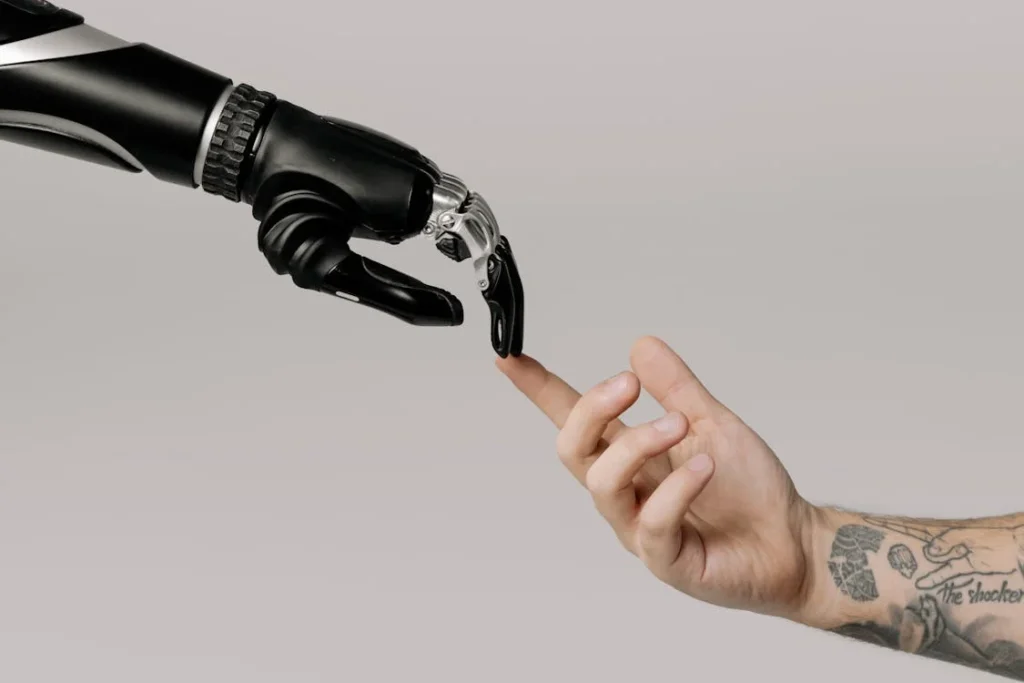
Measuring Progress Without Pressure: Rethinking Metrics in Adaptive Rehab
Why Metrics Matter—but Need a Makeover
In traditional rehabilitation, progress is measured by numbers—how far you walked, how fast you moved, how many reps you completed. These metrics are useful, but they can also be misleading. They don’t always tell the full story, especially for prosthetic users whose journey is full of ups, downs, and restarts.
Sometimes, someone makes incredible emotional progress—like walking confidently outside for the first time—but the data doesn’t capture that. Other times, someone might complete more reps but with worse form, simply because they’re rushing or overexerting. Standard metrics don’t always reflect effort, pain, hesitation, fear, or fatigue—all of which matter in recovery.
That’s why adaptive rehab systems need a new way to measure success. One that recognizes growth beyond the stopwatch. One that tracks movement without creating pressure. One that respects the whole person, not just their speed or numbers.
The Risk of Over-Measuring in Sensitive Moments
There’s a danger when users feel like they’re being watched too closely. If every action is tracked and judged, therapy can start to feel like a test. Some people, especially those recovering from trauma, become nervous. They start overthinking. They perform worse—not because they aren’t capable, but because they’re under pressure.
At Robobionics, we’ve seen this happen. A young girl named Meher, learning to use a myoelectric hand, became hesitant each time she saw her “score.” She would freeze, worry about doing it “right,” and eventually asked to stop using the device.
The problem wasn’t the tool—it was how progress was presented. Numbers without context can feel cold. So, we redesigned her interface to show personal bests, not raw scores. We focused on celebrating effort. “You completed a full session today!” instead of “Your accuracy was 72%.” The result? She began looking forward to therapy again.
Introducing Soft Metrics: Listening Beyond Movement
Soft metrics are qualitative signals collected through sensors, AI analysis, and user input. These include:
- Consistency: Did the user keep a steady rhythm?
- Relaxation: Was there tension in posture or muscle contraction?
- Recovery speed: How long did the user need between reps?
- Responsiveness: Did the user engage quickly or need prompting?
- Emotion cues: Were there changes in facial expression or hesitation?
These soft signals don’t replace numbers—but they enhance the story. A user might not complete more reps, but they may have shown better form, more confidence, or smoother transitions. That’s worth celebrating. And with adaptive systems, these insights can be gathered passively, without interrupting the experience.
Showing Progress Without Pressure
The way we show progress matters just as much as how we measure it. Traditional dashboards filled with graphs, scores, and error rates can overwhelm users. Adaptive systems need to present progress gently and meaningfully.
We’ve found that visual journeys work best. Instead of bars and graphs, we use story paths. As the user improves, their character moves through a landscape—climbing a hill, lighting lanterns, opening doors. It’s simple, visual, and symbolic. It shows that progress is happening—even if today’s session felt tough.
We also include effort badges: “You showed up today.” “You completed your third session in a row.” “You improved your form.” These achievements build emotional reinforcement that’s often missing in clinical rehab.
For more advanced users, data can still be presented—but only when requested. The goal is to keep data supportive, not stressful.
Customizing Metrics for Each Personality
Not everyone is motivated by the same kind of feedback. Some people love seeing numbers. Others just want to feel good. That’s why adaptive difficulty must extend to feedback style as well.
At Robobionics, we give users the option to choose their feedback mode during onboarding:
- Coaching mode: More detailed corrections, metrics, and tips.
- Supportive mode: Focused on encouragement and emotional wins.
- Balanced mode: A blend of both, with optional data summaries.
We’ve even added mood check-ins—a simple “How are you feeling today?” before a session. Based on that response, the system adjusts the feedback style. On anxious days, it might hold back on critiques. On focused days, it might give more structured guidance.
This humanized approach turns metrics from something done to the user into something that works for the user.
What This Means for Long-Term Rehab Engagement
When users feel seen—not just tracked—they stay longer. They show up even on hard days. They’re more honest about their struggles. They treat rehab as a part of life, not an interruption.
And when caregivers and therapists receive balanced reports—not just cold data—they make better decisions. They know when to push, when to pause, and when to simply support.
This rethinking of progress—away from pressure, toward purpose—is one of the most powerful shifts in adaptive rehabilitation. It reminds us that numbers are tools, not definitions. And that the heart of recovery lies not in how fast you move, but in the fact that you keep moving at all.
Conclusion
True rehabilitation isn’t just about movement—it’s about momentum. And momentum doesn’t come from pushing harder. It comes from being challenged at the right time, in the right way, with just enough support to keep going.
Adaptive difficulty allows us to meet users where they are, whether in clinics, homes, schools, or workplaces. It helps people grow without burning out. It personalizes rehab without overwhelming. And most importantly, it listens—not just to muscles, but to minds, moods, and motivation.
At Robobionics, we believe the future of prosthetic care isn’t in making things harder or faster. It’s in making recovery smarter. Systems that learn from users. Goals that shift with energy. Progress that feels good, not forced.
Because when people feel supported—not tested—they keep showing up. And when they keep showing up, healing becomes not just possible, but inevitable.



